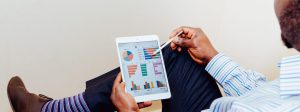
A person who has images, thoughts and impulses that cause a disruption in his life, as well as anxiety, is diagnosed with Obsessive-Compulsive Disorder (OCD). A common disorder, OCD is chronic, and the thoughts and behaviors make the individual feel that he has to repeat the response to the obsession many times.
At certain times, most people feel like they need to check things twice—to make sure a door is locked, an iron is turned off or the burners on the stove are off. But, individuals with OCD have uncontrollable thoughts that make them check things repeatedly or carry out routines that can last one or more hours a day. When the individual performs these routines/rituals, he may feel a sense of relief from anxiety, but it is only temporary. When OCD is not treated, these thoughts/rituals can result in extreme distress and disrupt the person’s life in many ways, including in a career, at school and in personal relationships.
The disorder is diagnosed in adults, adolescents and children in all walks of life and on every part of the globe. The diagnosis is made in most people by about the age of 19. It is usually diagnosed earlier for boys than in girls, and onset is known to occur after the age of 35, according to the National Institute of Mental Health.
Examples of Obsessive-Compulsive Disorder DSM-5 300.3 F42
According to the Diagnostic and Statistical Manual of Mental Disorders, Fifth Edition (DSM-5)*, OCD is distinguished by obsessions and compulsions or a combination of both.
Obsessions occur repeatedly in a person’s mind. As much as he wants them to stop, they continue. Compulsions are rituals that drive a person to act on them repeatedly, and they are usually done to attempt to make the obsessions stop.
People with OCD typically fall in one of the following categories.
- People who wash are frightened of contamination and commonly clean their hands compulsively.
- People who constantly check on things, such as locking doors and turning off ovens and stoves, relate these items with danger/harm.
- Individuals who are considered doubters/sinners feel that if all things are not done perfectly, something bad will happen or they will receive punishment.
- People who count and arrange items want order. Everything must be aligned just right. They can be superstitious about numbers, how things are arranged and colors.
- Some people are afraid that if they throw things away something terrible will happen. They have a compulsion to hoard items that they do not need or will not use.
*The DSM-5 is published by the American Psychiatric Association.
Symptoms of Obsessive-Compulsive Disorder DSM-5 300.3 F42
Some people with OCD may have a tic disorder, which is a sudden, quick, repeated movement, such as blinking, shrugging or smirking. The tics can be vocal like clearing the throat, sniffing or making grunting noises.
The following are some of the obsessions an individual may display.
- A fear of germs.
- A fear of losing something.
- Apprehension of harm toward himself or other people.
- Forbidden thoughts that are unwanted, such as those relating to sex and religion.
- Keeping things lined up perfectly (symmetrically).
Some of the compulsions people may have include the following.
- Constantly washing a part of the body.
- Hoarding.
- Arranging things in a particular way.
- Repetition with checking things.
- Repetition with counting things.
- Has a constant need to be reassured.
Causes of Obsessive-Compulsive Disorder DSM-5 300.3 F42
OCD may have to do with genetics, because it seems to run in families. It is unclear why some members of the family have OCD, and others do not. It typically starts in adolescence or early adulthood, and appears in boys at a younger age than it does in girls.
Research has found that parts of the brain and biological processes are key in OCD and its related fears and distress. In addition, researchers found that individuals who have been physically or sexually abused are at a higher risk of developing the disorder.
It is interesting to note that some children may develop OCD suddenly—or the condition may worsen—after a bout with streptococcal infection. Autoimmune syndrome, also known as Pediatric Autoimmune Neuropsychiatric Disorder Associated with Streptococcal Infections occurs after the strep infection. (https://www.nimh.nih.gov/health/topics/obsessive-compulsive-disorder-ocd/index.shtml)
Causes of Obsessive-Compulsive Disorder DSM-5 300.3 F42
According to the International OCD Foundation, the treatment for most people with OCD should include Exposure and Response Prevention (ERP) and/or medication. A majority of individuals with OCD—or seven out of 10—benefit from either ERP or medication. In ERP, the fears or obsessions are slowly revealed or exposed. The therapist will work with the individual to find healthy ways to cope with the anxiety and stress. The International OCD Foundation found that an estimated 70 percent of individuals who used ERP and/or medication for OCD had positive results.
Cognitive Behavioral Therapy helps to educate the individual about different ways to think, behave and react to the obsessions and compulsions.
Famous People with Obsessive-Compulsive Disorder
Actress Cameron Diaz, who starred in many movies, said she has a fear of germs that has led her to cleaning doorknobs in her home repeatedly. She admitted that it got so bad that she had faded the paint on the door around the doorknob.
President Donald Trump said he has borderline OCD having to do with his fear of germs. He doesn’t shake hands with others, particularly teachers, who he said have thousands of germs on their desks. Interestingly enough, he never touches the button on the elevator for the ground floor (the most popular button on the elevator).
Actor Leonardo DiCaprio, who starred in many box office smashes, said he had an obsession with sidewalks as a kid. He would repeatedly take the same routes he walked over and over again. He used his OCD tendencies to his advantage when he played Howard Hughes, who was known to have OCD, in Aviator.
Comedian Howie Mandel does not shake hands with others because he is afraid of germs. In fact, he has shaved his head, not for a particular style he wanted, but to feel cleaner. Mandel wrote about OCD in his book, “Here’s the Deal: Don’t Touch Me.”
Let’s keep in touch! Sign up to receive our newsletter:
Start a Relationship with An Exceptional Counselor
- Skilled and caring professional counselors
- Accepting all major and most insurances
- High-touch customer service & premium benefits
- Same- or next-day appointments
- Ultra-flexible 23.5hr cancellations













